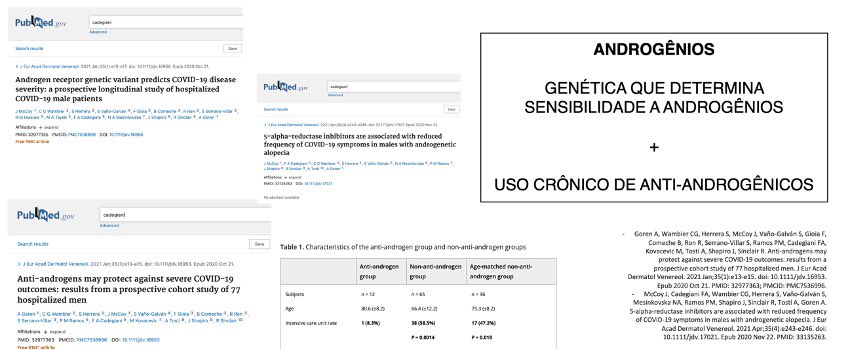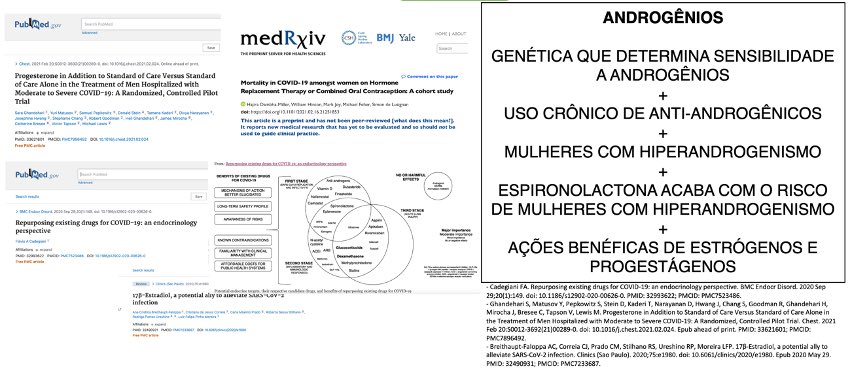
The androgen theory on COVID-19 and anti-androgens as promising therapies for COVID-19: the (almost) full story. (Thread - ENGLISH VERSION)
1/44 Studies with proxalutamide resulted from a solidly constructed scientific knowledge pathway. In this thread, I briefly describe the process from the beginning.
2/44 Since the beginning of the pandemics, men were found to be at higher risk for severe COVID-19, irrespective of other risk factors. 

3/44 In March 2020, overrepresentation of bald men was found in among patients in ICU due to COVID-19 in Spain. This finding was consistent across several countries, which was further confirmed to be an independent risk factor for COVID-19. 

4/44 How could we justify male alopecia (baldness) to be a risk factor for COVID-19? The justification was not only found to exist, but was strong. SARS-CoV-2, the virus that causes COVID-19, enters into cells through a protein called ACE2.
5/44 However, in order to couple to ACE2 and enter into cells, the virus must be ‘prepared’ by another protein, an enzyme called TMPRSS2. Without this ‘preparation’, the ability of the virus to infect cells becomes much weaker.
6/44 The point is that the only known regulator of TMPRSS2 are the androgens (hormones with ‘testosterone actions’).
7/44 Male baldness is a sort of maximized biological expression of high androgen activity, resulted from the in-tissue ratio between androgenic hormones and sensitivity of androgen receptors (more sensitive receptors lead to more testosterone action).
8/44 The resulting equation can be called as ‘level of androgen activity’. Bald men has therefore ‘high androgenic activity’ (which does not necessarily correlates with sex drive, muscles, etc).
9/44 High androgen activity leads to high TMPRSS2 expression. Consequently, the COVID-19 virus gets ‘more prepared’ to couple to ACE2 and gets more easily into cells. This leads to increase in SARS-CoV-2 infectivity (ability to infect) and pathogenicity (ability to cause harm).
10/44 Further epidemiological data reinforce the hypothesis. Pre-pubertal children have way less severe COVID-19, while babies under 1 y/o have relatively higher risk of severe COVID-19 than pre-pubertal children above 1 y/o.
11/44 This likely happens due to a physiological phenomenon called ‘mini-puberty’: babies under 1 y/o may have unblocked steroid hormonal production.
12/44 Although women have much lower testosterone and overall androgen levels than men, their androgen receptor tends to be more sensitive. That’s why females may present severe COVID-19, in special women with higher androgen activity.
13/44 While men are at higher risk of severe COVID-19, those at androgen deprivation therapy for severe prostate cancer, supposedly to be at higher risk due to the frailty of sarcopenia and metabolic disorders due to lack of testosterone action, were actually protected.
14/44 We have also observed that anabolic steroid users tend to be at higher risk for sever COVID-19, even whey completely healthy. 

15/44 Altogether, the data supporting the androgen theory on COVID-19, as well as the seemingly protective effect of androgen blockage, led us to hypothesize that anti-androgen approaches could be a promising tool against COVID-19.
16/44 We started to search for additional preliminary evidence actively, in order to identify whether there would be further support to our hypothesis.
17/44 We found in other situations that chronic use of anti-androgens (drugs that act inhibiting testosterone or any androgen activity) was found to be protective, in both hospitalized men and early COVID-19.
18/44 In addition, the variations of the gene that determined androgen receptor sensitivity were found to be independent predictors of COVID-19 severity. 

19/44 The same sort of correlation between androgens and COVID-19 severity was found in women. Women with excess androgen activity (hyperandrogenism), including polycystic ovary syndrome (PCOS), hair excess (hirsutism), or alopecia tended to present more severe COVID-19.
20/44 However, as a sort of ‘retrospective proof of concept’, women with hyperandrogenism taking spironolactone, an anti-hypertensive with anti-androgenic activity, were found to present milder disease than other women. 

21/44 In the top of that, women under feminine hormonal replacement therapy were found to be at lower risk for COVID-19. 

22/44 In our pre-trial observational study, we observed that add-on therapies with spironolactone or dutasteride, two anti-androgen agents, were found to be critical for quicker and milder COVID-19 (unpublished, under review, not on preprint).
23/44 Considering all the data supporting our hypothesis for anti-androgens as being promising options for COVID-19, we had sufficient plausibility and evidence to propose randomized clinical trials (the ‘gold standard’ of clinical research) to test anti-androgens for COVID-19.
24/44 We first tested dutasteride for male COVID-19 outpatients. Results were encouraging and somewhat unexpectedly good (primary data to be published). 

25/44 With good results obtained with dutasteride, we decided to search for more potent anti-androgens, the non-steroidal anti-androgens (NSAAs), the drugs used for androgen deprivation therapy in end-stage prostate cancer.
26/44 We tried to get several molecules: darolutamide, enzalutamide, bicalutamide….but the only when we were able to get donations was proxalutamide, from a Chinese startup called Kintor.
27/44 Proxalutamide was actually a good candidate since it demonstrated to be up to 10 times more potent than other drugs of the same class, and was also found to act in ACE2, critical for COVID-19.
28/44 We started testing proxalutamide in COVID-19 outpatients. First in men, and then in women. Both sexes demonstrated a substantial reduction in hospitalization rate.
29/44Link males: frontiersin.org/articles/10.33…
30/44 Link females: medrxiv.org/content/10.110… 

31/44 Interestingly and surprisingly, we observed an important reduction of inflammatory and thrombogenic markers unrelated to use of other drugs. This could’ve justified the reduction of hospitalization rate with proxalutamide.
Link: researchgate.net/publication/35…
Link: researchgate.net/publication/35…
32/44 The unexpected findings of potential effects beyond direct antiviral action allowed us to hypothesize that proxalutamide could also work in later, already hospitalized COVID-19.
33/44 We have then conducted a study with hospitalized patients at a very high level of control for biases, that demonstrated an almost undoubtable reduction of mortality rate. Link: medrxiv.org/content/10.110…
34/44 In fact, the reduction of mortality was followed by considerable improvement of percentage of lungs affected compared to placebo, as analyzed by independent blinded experts.
Link: medrxiv.org/content/10.110…
Link: medrxiv.org/content/10.110…
35/44 To add more plausibility, enzalutamide, a ‘drug sister’ of proxalutamide, was demonstrated to reduce SARS-CoV-2 virus entry in lung cells through reduction of TMPRSS2 expression.
Link: nature.com/articles/s4146…
Link: nature.com/articles/s4146…
36/44 For those afraid of ‘castration’, treatment is of short-duration (unlike treatment for prostate cancer), and instead of reducing testosterone and sperm production, it may actually protect from COVID-19 induced low testosterone and infertility.
37/44 Male infertility and reduction of testosterone in males are being increasingly demonstrated to occur in COVID-19, likely due to direct actions of the virus in Sertoli and Leydig cells in testicles.
38/44 Indeed, low testosterone levels dosed in already infected men demonstrated to be an independent risk factor for COVID-19 related complications.
39/44 Considering that level of reduction of testosterone levels may indirectly but precisely indicate the level of SARS-CoV-2 infectivity and pathogenicity, it makes a lot of sense that lower testosterone levels would be found in more severely affected men.
40/44 And this is completely different from the status of androgen activity, that encompasses other hormones than testosterone, as well as the sensitivity of androgen receptor.
41/44 In short, there is consistent epidemiological observation and considerable biological plausibility to allow the androgen hypothesis on COVID-19.
42/44 The hypothesis was progressively reinforced by further studies showing potential protection of anti-androgens for COVID-19 and strong correlation between ‘androgen status’ and COVID-19 severity.
43/44 All findings were corresponding and provided sufficient substantiation for the conduction of trials on anti-androgens for COVID-19. These trials demonstrated protective effects of anti-androgens on COVID-19 at a variety of outcomes measured, in different populations.
44/44 In conclusion, this was a well-constructed scientific pathway, built under a road of observational discoveries, followed by therapeutical demonstration of efficacy. The beauty of pure science built in its purest way.
Extra 1: COVID-19 is an endocrine-mediated disease, since SARS-CoV-2 infectivity is regulated by renin-angiotensin-aldosterone system (RAAS), the main system that determines the blood pressure, and which is abnormal in metabolic and inflammatory diseases, and androgen activity.
Extra 2: The European Society of Endocrinology (ESE) has recognized and endorsed our theory, providing further authoritative strength to the findings.
• • •
Missing some Tweet in this thread? You can try to
force a refresh











